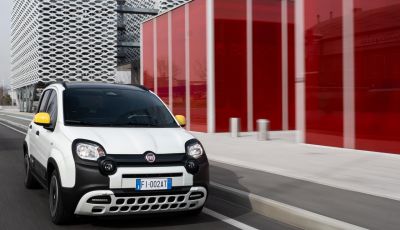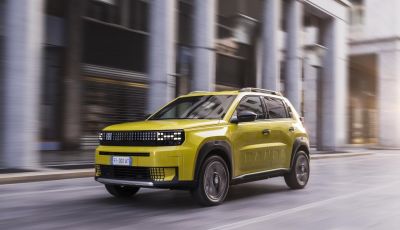Land Rover nuova Freelander – Test Drive

New Land Rover Freelander – Test Drive
A luxury 4×4
Cortina d’Ampezzo (Italy) – Land Rover is a brand protagonist in the premium 4×4 class. With its new Freelander, Land Rover wants to put together both a true 4×4 tradition and fashion. This is much more evident in the last generation, which has become a real protagonist inside the luxury SUV segment.
The fourth model in over four years
The all-new Freelander 2 is the fourth new model to be launched by the Land Rover in as many years, following in the wake of the Range Rover, Discovery 3 and the Range Rover Sport.
The car redefines the compact premium 4×4 class. New from the ground up, Freelander 2 delivers outstanding on-road performance as well as the class-leading off-road ability of a true Land Rover. A dynamic design, purposeful stance, smart and spacious interior, and an abundance of advanced technologies complete the package.
“No other compact 4×4 has anything like its total breadth of capability,” says Phil Popham, Land Rover’s managing director. “The Freelander 2 sets new standards in the sector, combining the advantages of a premium car – such as polished ride, accomplished performance, attractive cabin and ease-of-use – with the attributes of a robust 4×4, including go-anywhere ability, toughness, panoramic seating, cabin versatility and spaciousness. We believe that no other compact 4×4 gets closer to blending these best-of-both-worlds abilities.”
Two new engines
Technical highlights of the Freelander 2 include two brand-new engines: a 3.2-litre straight-six petrol and a 2.2-litre four-cylinder turbocharged diesel. Both feature advanced technologies to deliver outstanding combinations of performance and economy.
The 233 PS (171 kW) i6 petrol engine provides a top speed of 124 mph (200 km/h) and 0-60 mph acceleration in 8.4 seconds (0-100 km/h in 8.9 seconds). Combined fuel economy is 25.2 mpg (11.2 litres/100 km). The engine is matched to a new six-speed automatic transmission, with Land Rover’s CommandShift™ offering manual sequential gear changes when required. There is also a driver-selectable sport mode, for livelier performance.
Straight-six engine configurations are ideal for delivering engine smoothness, and the very compact new unit in Freelander 2 is small enough to mount transversely, a first in the compact 4×4 sector and one of the vehicle’s many innovations. The benefits of transverse fitment include improved interior package and safety performance.
The diesel engine chosen for Freelander 2 is an all-new 2.2-litre four-cylinder. The 160 PS (118 kW) unit delivers peak torque of 400 Nm (295 lb ft), with over 200 Nm (148 lb ft) of torque from 1000 rpm all the way to 4500 rpm. The engine is easy and responsive to drive, as well as highly refined and economical, with a combined average fuel consumption of 37.7 mpg (7.5 l/100 km). An optional catalysed Diesel Particulate Filter (cDPF) is also available for even cleaner performance. Two transmissions are offered: a new six-speed manual gearbox and the same six-speed automatic used on the petrol engine (diesel auto available from Spring 2007).
Bigger dimensions
The interior package of Freelander 2 is a major improvement over the outgoing vehicle. Although only 50 mm longer, the Freelander 2 has more generous head, shoulder and legroom, in both the front and rear.
All’esterno invece, l’aumento di dimensioni quasi non si nota, grazie ad un design comunque compatto e piacevole. Spiccano i nuovi paraurti con molti particolari in tinta, delicati nei parcheggi ma molto valorizzanti esteticamente, ed il frontale ispirato alle “sorelle” più grandi.
Large glass areas emphasise the spacious feel and complement the elevated ‘command driving’ position – a Land Rover hallmark – and ‘stadium seating’, where rear passengers sit slightly higher than front occupants, for a clearer view of the world outside. Boot space is also among the best in class and 38 per cent larger than that of the outgoing Freelander (with rear seats up – 755 litres vs 546 litres).
The exterior and interior design of Freelander 2 is completely fresh, integrating the company’s unique design language with a form that is instantly recognisable as the latest Land Rover.
Innovative technology
Freelander 2 is packed with new technologies to improve both on-road and off-road performance, many new to the class. Land Rover’s unique Terrain Response™ is standard on all but the entry-level model, to make off-roading easier. Other interesting technologies include a new full-time intelligent 4×4 system for superior traction and better on-road fuel economy, and the patented Gradient Release Control, which improves driver confidence and control when releasing the brakes on steep and slippery slopes.
Other features and options rare in this class include: keyless starter button, bi-xenon headlamps, adaptive front lighting, rain-sensing wipers and park distance control (front and rear). A two-part panoramic sunroof increases the cabin’s airiness: air-conditioning is standard on all models and a full colour touch-screen DVD satellite navigation system is also available. The choice of top-level audio systems includes DAB digital radio and 12-speaker Dolby™ Prologic IIx Surround Sound with fibre-optic interconnects. An auxiliary audio connection (for iPods and MP3 players) is standard on all vehicles.
Designed and engineered by Land Rover at Gaydon, near Warwick, Freelander 2 is built at the Halewood plant in Liverpool, where outstanding build quality has been acknowledged with a JD Power European Plant Quality Gold Award in 2005.
On the road
Freelander 2 is improved in every way: better performance, more economical, more refined, higher quality and substantially roomier. It is more capable both off-road and on-road, with transformed handling, ride and comfort.
The body is a five-door monocoque structure, with a high level of torsional rigidity which benefits refinement, comfort and handling on-road as well as ensuring the vehicle is fit for serious off-roading. The suspension is fully independent and uses the most modern stability control systems, including Roll Stability Control (RSC), a new and sophisticated technology that helps mitigate the risk of roll-over.
Dynamics is good, but what really hits is: maximum performances and no vibrations.







































































































